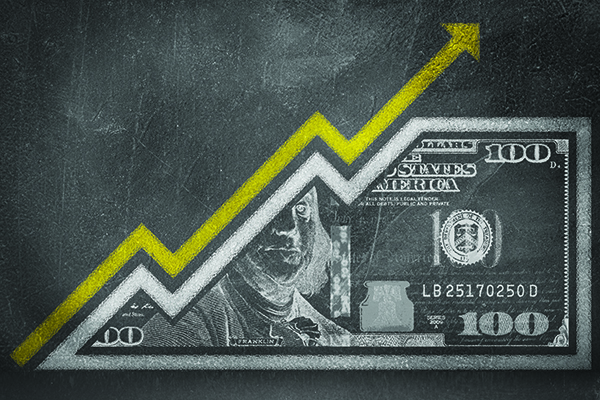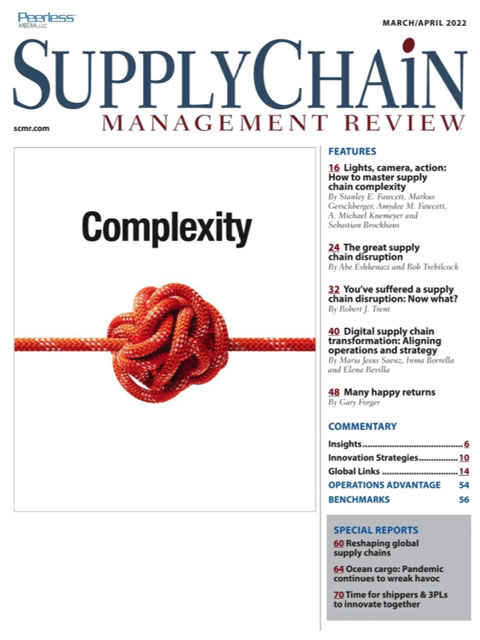Sorry, but your login has failed. Please recheck your login information and resubmit. If your subscription has expired, renew here.
March-April 2022
Yesterday, I hosted a webinar on the steps supply chain leaders are taking to redesign their supply chains to cope with this period of unprecedented demand. Earlier last month, I attended the Manifest conference in Las Vegas. The exhibitors featured a lineup of supply chain startups while the attendee list was dominated by venture capital firms looking to get in on the action in our booming industry. This morning, one of the lead news stories is about another disruption threatening to bring global supply chains to a halt: Browse this issue archive.Need Help? Contact customer service 847-559-7581 More options
Inflation awoke from its slumber in 2021, as the US Producer Price Index quadrupled relative to the preceding decade. Inflation takes two forms: cost-pull inflation, driven by higher input prices; and inflation that occurs when demand persistently outpaces supply. Cost-pull inflation is currently evident across global supply chains in the rising cost of everything from raw materials (e.g., metals +26%, wheat +50%), to energy (+110%), to transportation (transpacific container +300%, air freight +50%, OTR freight +20%) and on through to labor, where companies must compete even for “unskilled” labor in many markets.
Unabated, inflation could depreciate currencies to further erode international purchasing power. Even if overall costs level off, unexpected price spikes seem likely to persist for certain essential items, particularly if supply is disrupted by unanticipated events.
There is no magic wand to make inflation disappear, but you can take decisive steps to safeguard your company’s operating margins. In fact, if you know where to look you can find profit-protection opportunities across your supply chain.
A classic example is “trimming the tail” on your product portfolio by eliminating SKUs that are not pulling their weight in terms of P&L, volume contribution and customer impacts. You can then use your streamlined portfolio and consolidated input volumes to gain traction with suppliers (e.g., reducing the number of beverage flavors within a brand allows a company to place larger orders on volumes for the remaining SKUs). You can expand on that approach by systematically focusing your capital, workforce and technology resources on high-margin, high-velocity products and brands with differentiated value propositions in proven growth markets.
Flexibility in product specifications and formulations is an oft-overlooked opportunity to preserve profits. You may be able to strip fairly significant costs out of your operations by simplifying product designs, such as reducing the number of parts, or by substituting materials that have little or no impact to consumers, such as using lower-cost frying oil in potato chip production.
Finally, inflation is a sharp prompt to actively experiment with pricing. Companies often enjoy far more latitude than they realize in certain parts of their product portfolios, and as a rule you can more easily pass rising costs along to some customers than to others. Scan your portfolio and customer base for instances where you have the relative leverage to strategically raise prices.
Thinking more broadly, the current environment is a perfect time to redefine external relationships via strategic sourcing and exploring joint venture or co-investment partnerships with your suppliers.
Cooperation versus competition
External approaches may run counter to first instincts. As costs rise, you could slip into a law of the jungle mindset where you see yourself pitted against suppliers and customers alike in a fight for survival. But some of the most impactful cost-containment strategies are achieved via cooperation rather than competition. For obvious reasons, value chain coordination is an arena where supply chain leaders can make particularly significant contributions.

This complete article is available to subscribers only.
Log in now for full access or start your PLUS+ subscription for instant access.
SC
MR
Sorry, but your login has failed. Please recheck your login information and resubmit. If your subscription has expired, renew here.
March-April 2022
Yesterday, I hosted a webinar on the steps supply chain leaders are taking to redesign their supply chains to cope with this period of unprecedented demand. Earlier last month, I attended the Manifest conference in… Browse this issue archive. Access your online digital edition. Download a PDF file of the March-April 2022 issue.Inflation awoke from its slumber in 2021, as the US Producer Price Index quadrupled relative to the preceding decade. Inflation takes two forms: cost-pull inflation, driven by higher input prices; and inflation that occurs when demand persistently outpaces supply. Cost-pull inflation is currently evident across global supply chains in the rising cost of everything from raw materials (e.g., metals +26%, wheat +50%), to energy (+110%), to transportation (transpacific container +300%, air freight +50%, OTR freight +20%) and on through to labor, where companies must compete even for “unskilled” labor in many markets.
Unabated, inflation could depreciate currencies to further erode international purchasing power. Even if overall costs level off, unexpected price spikes seem likely to persist for certain essential items, particularly if supply is disrupted by unanticipated events.
There is no magic wand to make inflation disappear, but you can take decisive steps to safeguard your company’s operating margins. In fact, if you know where to look you can find profit-protection opportunities across your supply chain.
A classic example is “trimming the tail” on your product portfolio by eliminating SKUs that are not pulling their weight in terms of P&L, volume contribution and customer impacts. You can then use your streamlined portfolio and consolidated input volumes to gain traction with suppliers (e.g., reducing the number of beverage flavors within a brand allows a company to place larger orders on volumes for the remaining SKUs). You can expand on that approach by systematically focusing your capital, workforce and technology resources on high-margin, high-velocity products and brands with differentiated value propositions in proven growth markets.
Flexibility in product specifications and formulations is an oft-overlooked opportunity to preserve profits. You may be able to strip fairly significant costs out of your operations by simplifying product designs, such as reducing the number of parts, or by substituting materials that have little or no impact to consumers, such as using lower-cost frying oil in potato chip production.
Finally, inflation is a sharp prompt to actively experiment with pricing. Companies often enjoy far more latitude than they realize in certain parts of their product portfolios, and as a rule you can more easily pass rising costs along to some customers than to others. Scan your portfolio and customer base for instances where you have the relative leverage to strategically raise prices.
Thinking more broadly, the current environment is a perfect time to redefine external relationships via strategic sourcing and exploring joint venture or co-investment partnerships with your suppliers.
Cooperation versus competition
External approaches may run counter to first instincts. As costs rise, you could slip into a law of the jungle mindset where you see yourself pitted against suppliers and customers alike in a fight for survival. But some of the most impactful cost-containment strategies are achieved via cooperation rather than competition. For obvious reasons, value chain coordination is an arena where supply chain leaders can make particularly significant contributions.
SC
MR


More Finance
- Services sector sees growth in October, reports ISM
- Looking back at NextGen 2024
- Manufacturing again contracts in October, reports ISM
- NextGen Supply Chain Conference set for October 21-23
- Estée Lauder, Schneider Electric and S&S Activewear to receive NextGen End User awards
- 2024 Robotics Application Conference announces session, speaker lineup
- More Finance
Latest Podcast

 Explore
Explore
Business Management News
- Strengthening customer fulfillment: Building a strategic stakeholder network
- The hard job of teaching soft skills
- Trump picks former Wisconsin congressman Sean Duffy for DOT secretary
- Made in Mexico, manufactured by China
- Retail sales see gains in October, reports Commerce and NRF
- Balancing green and speed: Home delivery insights from the pandemic era
- More Business Management
Latest Business Management Resources

Subscribe

Supply Chain Management Review delivers the best industry content.

Editors’ Picks





